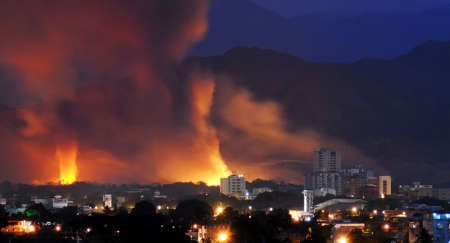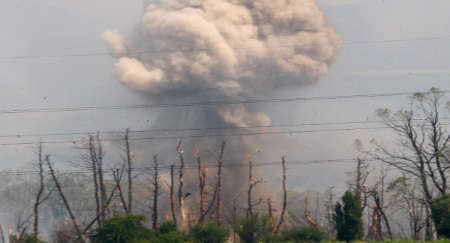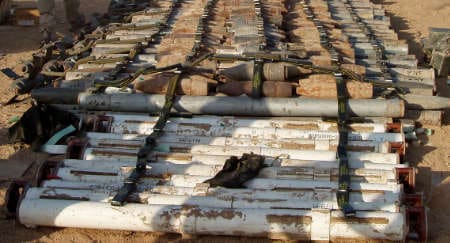Since 2009, there have been more than 50 recorded incidents of unplanned explosions at munitions depots in 34 countries. This is not a case of bad luck argue Eric Berman, Pilar Reina and Pierre Gobinet
Since 2009, there have been more than 50 recorded incidents of unplanned explosions at munitions depots in 34 countries.
This is not a case of bad luck.
It is symptomatic of the poor state and dangerous conditions under which many countries’ state security forces store their munitions (used here broadly to include military weapons, ammunition, and related ordnance).
Improper storage and handling frequently occur where accounting practices and oversight are weak or absent. This facilitates corruption and diversion, which are serious problems. This article, however, addresses the direct and, to a lesser extent, indirect, consequences of these explosions.
In January 2002, a series of explosions at a military depot on the outskirts of Lagos, Nigeria, resulted in more than one thousand deaths
A single such event can result in dozens of dead and hundreds of injured. The death toll has at times been much higher.
In January 2002, for example, a series of explosions at a military depot on the outskirts of Lagos, Nigeria, resulted in more than one thousand deaths, with many people drowning in nearby canals when fleeing the fires and explosions.
In February 2004, ammunition and explosives reportedly detonated accidentally in Seonggang, North Korea, resulting in similar levels of casualties.
According to a list compiled by ammunition expert Adrian Wilkinson, over the past 16 years the average unplanned explosion has resulted in more than 15 deaths and 20 injured. Exact numbers are hard to obtain.
Moreover, the casualties are likely to increase when civilians subsequently come into contact with unexploded ordnance (UXO) dispersed by the explosion.
It can also result in the displacement of thousands. In September 2005, a series of explosions at a navy yard in Yuzhanaya Koriakaya in the Russian Federation resulted in the evacuation of some 7,000 residents by one account.
Five times as many people were displaced in and around Khandroo, India, in August 2007 following a major fire destroyed an ammunitions shed.
The damage to infrastructure can be extensive. While some depots are isolated from neighbouring settlements, many are located in heavily populated areas.
In Riobamba, Ecuador in November 2002, a depot explosion that some residents likened to an earthquake or a volcanic eruption, affected an area covering a 2 km radius from the blast site. By one account, more than 15,000 dwellings were damaged.
More than 300 buildings were reportedly destroyed in six villages from an explosion that occurred in Melitopol, Ukraine in May 2004. The March 2008 munitions explosion in Gerdec, Albania, resulted in hundreds of homes being destroyed and hundreds more severely damaged. Some reports put the numbers in the thousands.
In Riobamba, Ecuador in November 2002, a depot explosion affected an area covering a 2 km radius from the blast site, damaging as many as 15,000 dwellings
And the loss of economic activity can top tens of millions of dollars and have long-term ramifications on livelihoods and the environment.
Following an explosion in Paracin, Serbia, in 2006, a main access road was reportedly blocked off for more than 24 hours, resulting in many millions of euros of lost trade. (The Serbian army subsequently removed more than 130,000 pieces of UXO in an eight square kilometres perimeter around the contaminated area.)
Unplanned explosions of munitions sites (UEMS) are a global problem. They have occurred from Afghanistan to the former Zaire. Since 1998, acts of this nature have been reported in almost a third of United Nations (UN) Member States and on every continent except Australia and Antarctica.
During this period, there have been nearly 250 such events recorded in 62 countries. Accidents have been especially prevalent in Afghanistan, India, Iraq, and the Russian Federation, with each of these countries recording between 15 and 25 mishaps. Such explosions have also occurred in 11 of 28 North Atlantic Treaty Organisation (NATO) members.
They have occurred regularly. Between 1998 and 2007, there was an average of a little less than three every two months. According to the forthcoming Small Arms Survey UEMS Database, this rate has increased to more than one every two weeks since 2008.
Indeed, in 2011 the pace of unplanned explosions has quickened, with 16 incidents recorded through to the end of May. It is unclear whether the problem is getting worse or reporting of incidents is improving. What is clear is that the number of explosions is not noticeably decreasing despite efforts to address their causes.
There are numerous causes for unplanned explosions at munitions sites. Most derive from a lack of technical knowledge and uneven attention to basic safety and security standards. The propellants, fuses, primers, and explosive components that comprise ammunition require trained experts to conduct routine physical surveillance and testing throughout the objects’ life-cycle.
If left out in the open unattended for years in heat and humidity for instance, the ammunition’s chemical components can degrade and become highly unstable. Poor storage practices and poor infrastructure together cause more than half of the known explosions.
Other frequent causes include negligence during handling and during transport of ordnance. That said, for almost one-third of reported explosions no cause is recorded
The international community is addressing this challenge. Ad hoc coalitions of the willing, such as nine countries in South-East Europe that comprise the Regional Approach to Stockpile Reduction (RASR) Initiative, underscore the importance states attribute to physical security and stockpile management (PSSM).
Several regional organisations have developed ‘best practice’ guidelines for PSSM. The 2010 Manual of NATO safety principles for the storage of military ammunition and explosives is one such example. The forthcoming United Nations Coordination Action in International Small Arms Controls Standards (ISACS) and United Nations Office for Disarmament Affaires International Ammunition Technical Guide (IATG) are ongoing noteworthy initiatives.
States can achieve positive results on their own through some inexpensive and effective first steps
States exhibiting strong political will – often with international assistance – can prevent unplanned explosions or mitigate their impact. International donors working bilaterally and through regional organisations have assisted dozens of governments to safely destroy surplus stocks of munitions and to secure remaining material in safe and secure conditions.
Since 2001, for example, the NATO Maintenance and Supply Agency (NAMSA) has been coordinating Partnership for Peace (PfP) Trust Fund projects to destroy significant quantities of surplus ordnance and improve PSSM practices in Eastern Europe, South-East Europe and the Middle East. Recipients include Afghanistan, Albania, Azerbaijan, Georgia, Jordan, Moldova, Ukraine and Uzbekistan.
Some solutions are expensive to implement and may require external assistance, but many can be undertaken unilaterally and with modest investment. Some sites may need to be closed, and their ordnance moved to another location at great cost.
New sites, incorporating quantity-distance principles and security features, may need to be constructed from scratch. Nevertheless, without necessarily striving to achieve state-of-the-art storage standards, a number of pragmatic measures can address the immediate risk of unplanned explosions.
States can achieve positive results on their own through some inexpensive and effective first steps. These include installing proper doors and locks, using adequate fences and barriers, posting signs to warn and inform, and organising the stockpile into stacks and aisles free of obstruction. Given the high costs in human and economic terms of unplanned explosions, policy-makers should find such modest investments very attractive.



